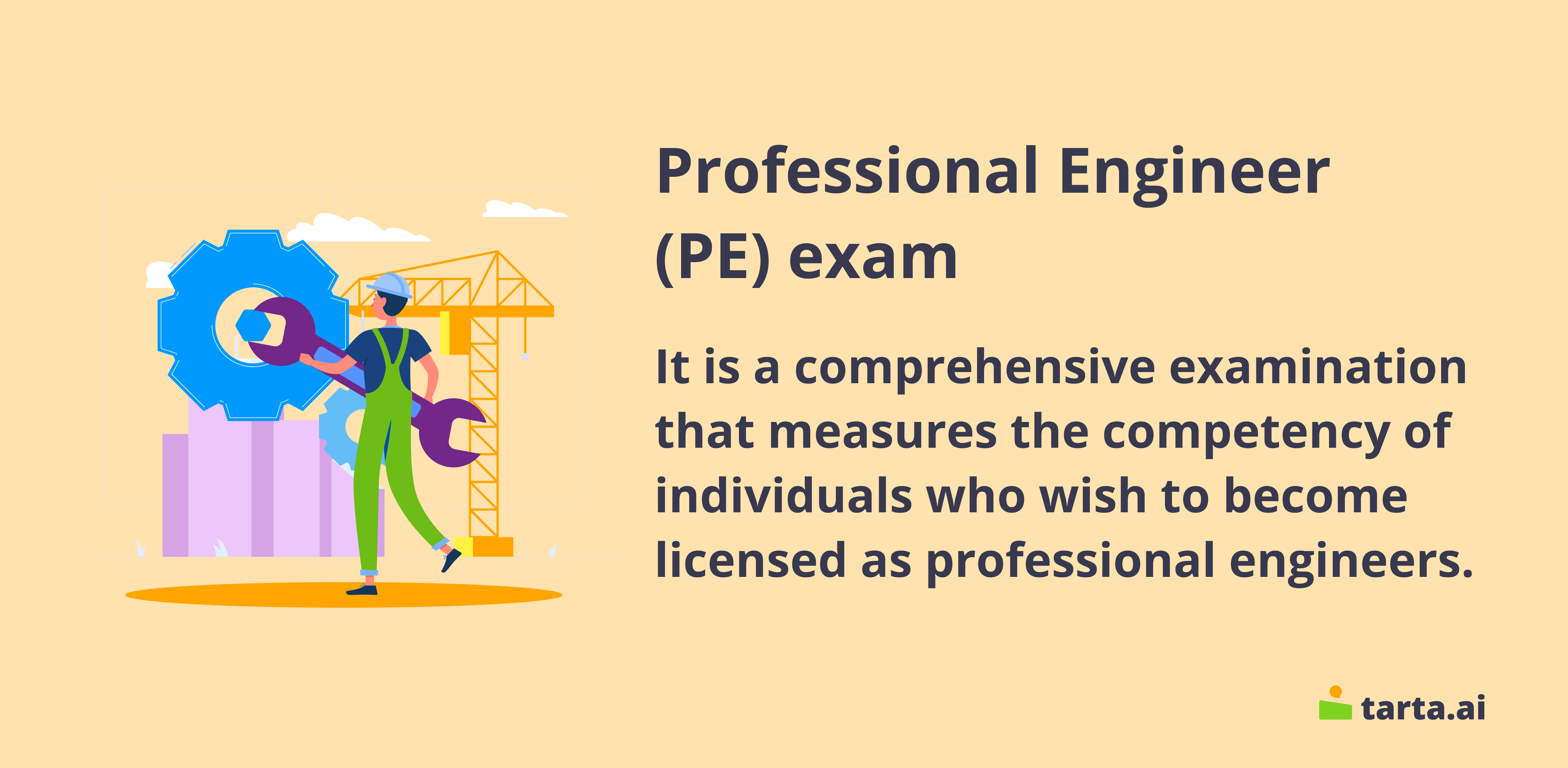Cracking the Professional Engineer (PE) Exam: Tips and Strategies for Success

Professional Engineer (PE) exam description
The Professional Engineer (PE) exam is a standardized test administered by the National Council of Examiners for Engineering and Surveying (NCEES) in the United States.
To be eligible to take the PE exam, individuals must typically have a minimum of a bachelor's degree in engineering from an accredited college or university and have completed a certain amount of professional engineering experience. The specific requirements for eligibility may vary by state or jurisdiction.
Passing the PE exam is a requirement for obtaining a professional engineering license in most states. A professional engineering license is necessary for individuals who want to offer their engineering services to the public or work on certain types of projects that require the involvement of a licensed professional engineer.
Interesting fact: The first PE exam was administered in 1907 by the state of Wyoming.
PE exam format
The format of the Professional Engineer (PE) exam may vary depending on the specific discipline in which you are seeking licensure. However, in general, the PE exam consists of two components: a computer-based multiple-choice exam (also known as the "PE Fundamentals of Engineering" or "FE" exam), and a discipline-specific paper-and-pencil exam.
- Computer-Based Exam (FE Exam): This is the first part of the PE exam, and it is taken on a computer at a Pearson VUE testing center. The exam consists of 110-120 multiple-choice questions and lasts for six hours. The FE exam covers basic engineering topics, such as mathematics, ethics, mechanics, thermodynamics, and electricity.
- Discipline-Specific Exam: This is the second part of the PE exam, and it is administered in a paper-and-pencil format. The discipline-specific exam consists of 40-80 multiple-choice questions and lasts for six hours. The exam focuses on topics specific to the particular engineering discipline you are seeking licensure in.
- Open-Book Exam: The discipline-specific exam is an open-book exam, which means you can bring in reference materials to use during the test.
- Closed-Book Sections: However, some questions on the discipline-specific exam may be closed-book, where reference material is not allowed.
- Calculators: Calculators are permitted during both the FE and discipline-specific exams, but they must meet certain requirements outlined by the exam board.

Disciplines
The Professional Engineer (PE) exam is offered in several engineering disciplines, including:
- Civil Engineering
- Electrical and Computer Engineering
- Environmental Engineering
- Mechanical Engineering
- Chemical Engineering
- Industrial Engineering
- Nuclear Engineering
- Petroleum Engineering
- Software Engineering
- Structural Engineering
- Aerospace Engineering
Each discipline-specific exam focuses on topics relevant to that particular engineering field, such as building codes and standards, safety, design principles, and engineering analysis. It's important to note that each state or jurisdiction may have different requirements for the PE exam and may offer exams in different disciplines. It's essential to check with your state licensing board for specific details on exam requirements and eligibility.
Note: The PE exam is a rigorous and comprehensive exam that tests not only technical knowledge but also professional skills, such as communication and ethics.
Tips to help you prepare for and pass the PE exam
Preparing for the Professional Engineer (PE) exam can be a daunting task, but with the right approach and mindset, you can increase your chances of success.
- Understand the exam format: The PE exam is a lengthy and comprehensive exam, so it is important to understand its format, structure, and content. Review the exam specifications and practice using sample exam questions to get a feel for the types of questions and format.
- Create a study plan: Develop a study plan that is realistic and fits your schedule. Set aside dedicated study time each day or week, and stick to it. Make sure you cover all the exam topics, and use practice exams to test your knowledge.
- Use reliable study materials: Use study materials that are reliable and recommended by professionals who have taken and passed the exam. These can include textbooks, reference materials, practice exams, and review courses.
- Focus on your weaknesses: Identify the areas where you need the most improvement, and focus your study efforts on those topics. Don't waste time on topics you already know well.
- Simulate the exam environment: Practice taking exams under timed conditions, as this will help you get used to the pressure and pace of the actual exam. Use the same reference materials and calculator that you will use on the exam.
- Stay calm and focused: On the day of the exam, stay calm and focused. Arrive early to avoid any last-minute stress, and take breaks as needed. Remember that it's normal to feel nervous, but don't let your anxiety affect your performance.
- Review your answers: Take the time to review your answers and make sure you have answered all questions. Don't rush to submit your exam until you have checked all your work.
- Keep a positive attitude: A positive attitude can go a long way in helping you stay motivated and focused throughout your exam preparation. Remember to take care of yourself, get enough sleep, exercise, and eat well.
The PE exam is recognized by many countries around the world as a measure of professional competence and is often a requirement for working as an engineer in those countries.
Benefits
The Professional Engineer (PE) exam gives individuals the opportunity to become licensed as a professional engineer. Being licensed as a professional engineer signifies that an individual has met certain education, experience, and examination requirements and is legally authorized to practice engineering in their state or territory.
Having a PE license can provide many benefits, including increased job opportunities, higher salaries, and greater recognition within the engineering profession. It can also give clients and employers confidence in the individual's technical abilities and professional ethics. Additionally, being licensed as a PE may be a requirement for certain engineering positions, especially those in the government or public sector.
Overall, the PE exam is designed to test your knowledge of fundamental engineering concepts and your ability to apply that knowledge to real-world engineering problems. It is a challenging exam that requires significant preparation and study
- The PE exam is a standardized test administered by NCEES in the United States, and passing the exam is a requirement for obtaining a professional engineering license in most states.
- The exam consists of two components: a computer-based multiple-choice exam (FE exam) and a discipline-specific paper-and-pencil exam, which is an open-book exam.
- The PE exam is offered in several engineering disciplines, and each discipline-specific exam focuses on topics relevant to that particular engineering field.
- To prepare for the exam, individuals should understand the exam format, create a study plan, use reliable study materials, focus on weaknesses, simulate the exam environment, stay calm and focused, review answers, and keep a positive attitude.
- Being licensed as a professional engineer can provide many benefits, including increased job opportunities, higher salaries, greater recognition within the engineering profession, and may be a requirement for certain engineering positions.
FAQ
What is the PE exam?
The PE exam is a standardized test administered by the National Council of Examiners for Engineering and Surveying (NCEES) in the United States.
Who is eligible to take the PE exam?
Individuals must have a bachelor's degree in engineering from an accredited college or university and have completed a certain amount of professional engineering experience.
What is the format of the PE exam?
The PE exam consists of two components: a computer-based multiple-choice exam (also known as the "PE Fundamentals of Engineering" or "FE" exam), and a discipline-specific paper-and-pencil exam.
What engineering disciplines is the PE exam offered in?
In several engineering disciplines, including civil, electrical and computer, environmental, mechanical, chemical, industrial, nuclear, petroleum, software, structural, and aerospace engineering.
When should I take the PE exam?
It's recommended to take the PE exam after gaining several years of professional engineering experience, as this will help you better understand the material and perform better on the exam.
How long does it take to receive PE exam results?
The timeline for receiving PE exam results can vary, but it typically takes several weeks to several months to receive results.